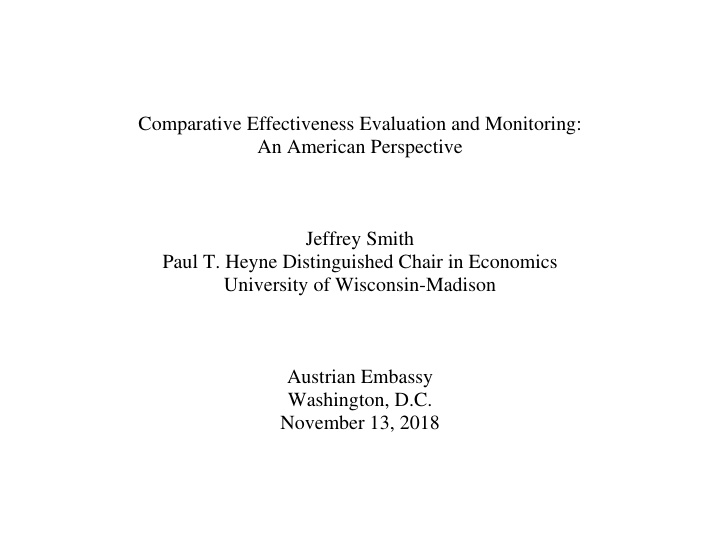



Comparative Effectiveness Evaluation and Monitoring: An American Perspective Jeffrey Smith Paul T. Heyne Distinguished Chair in Economics University of Wisconsin-Madison Austrian Embassy Washington, D.C. November 13, 2018
Outline of talk What sites do What is the point of the measures? Remarks on choosing the set of conditioning variables The technocratic ideal Applied econometric issues Opportunity knocks!
What do sites do? Recruiting Selecting Testing Informing Assigning Motivating Following up Monitoring
What is the point of the adjusted outcome measures? Monitoring? Description? Performance management? Evaluation? Identifying outlier sites (on the high side or the low side) More than one of these? The goal matters for the design and use of the system that creates and interprets the adjusted outcome measures
An aside on comparative effectiveness What does effectiveness mean? Long-run impacts? Short-run impacts? Something else? What do the adjusted outcome measures compare? Not different programs, but different versions of the same program operated in different locations
Conditioning variables: participants or eligibles? Existing systems condition on participant characteristics But sites choose these! In particular, they choose: 1) Where and how to market their programs 2) How to triage potential participants who apply To really “hold sites harmless” the models should adjust for the characteristics of the eligible population rather than of participants
Conditioning variables: training type Is this wrong? Depends what you want to do with the system. Training type represents a “mediator” in program evaluation jargon Conditioning on it removes that aspect of the sites’ performance
Conditioning variables: providers Even within a state, sites differ in the nature, number and quality of available service providers Not all community colleges are created equal! Particularly but not entirely an urban / rural issue Should find a way to quantify this and include it in the model
Conditioning variables: conditional independence Do the US administrative data contain variables that would suffice to make conditional independence plausible? Technically, conditioning on some but not all of the variables required for conditional independence need not reduce the bias relative to no conditioning Does some but not full conditioning suffice to get the ranks right? Are ranks enough, given the purpose of the system? Should program staff understand the adjustments? SRI study of the JTPA adjustments How much can program staff control participant characteristics?
Other substantive issues Estimate separate models for each state? What do the data have to say? Perhaps groups of similar / nearby states as an intermediate position How many years of data to use? How stable are the coefficients? Again, let the data speak. How many sites have low numbers of participants per year? Should the analysis combine small sites? What about services received outside the program? Not an issue in Austria, very much an issue in the US Use WIA experiment survey data to get a handle on this Someone mislaid the costs … finding them means measuring them
The technocratic ideal Do on-going random assignment to “core” services only Similar to the set-up in the WIA experiment No need to consent if part of on-going program? Still only provides short-run impacts (in the short-run)
Applied econometric issues “Sample (really the population) size” and shrinkage No reason to worry overmuch about logit versus probit versus LPM
Opportunity knocks! The point of the system matters for its design Think hard about what to condition on and why Worry about how local program stuff will understand the system: Conditioning, causality, and cost-benefit Many substantive and applied econometric challenges Combine with systematic institutional variation among sites A real opportunity here to improve on both the current system and the JTPA system that included conditioning
Recommend
More recommend